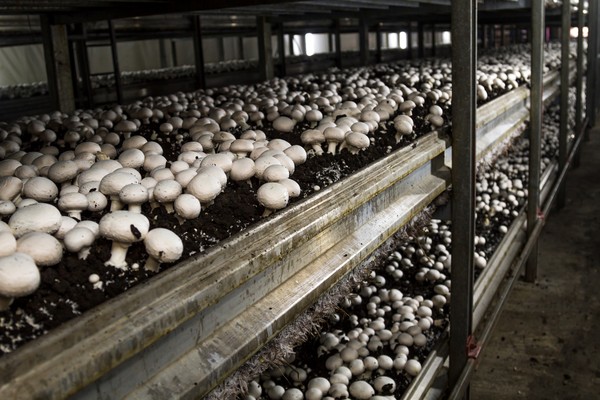
Mechanization of cultivated mushrooms
From purely manual execution, the harvesting of cultivated mushrooms has evolved through progressive levels of mechanization to fully robotic execution, benefiting productivity and final product quality, particularly in terms of overall cleanliness and absence of contamination
Cultivated mushroom production. Marketed in different varieties and categories, mushrooms are a popular food on tables around the world. In order to meet global demands, natural production has long been insufficient, so it has been necessary to create a suitable, mechanized, dedicated cultivation chain. The most widespread cultivated mushroom variety is undoubtedly Agaricus bisporus, commonly known as "champignon," in white or cream-colored versions, accounting for about 80 percent of the global quantity. The production cycle is rather short, from preparing the substrate for inoculation to harvesting the fruiting bodies.
Substrate preparation
Careful evaluation of substrate characteristics, particularly concerning texture and pH, is required. Generally, the base is a mixture of woody residues, straw, and other inert principles, properly chopped to obtain a fibrous compound with little susceptibility to compaction. After a preventive phase of sterilization or pasteurization by steam or hot water baths to eliminate possible pathogens and species that could create competition, the components are mixed in varying proportions, added with buffering principles to stabilize the pH, and finally irrigated to promote the rooting and growth of the spores, or hyphae, to be inoculated.
The substrate is then brought to a temperature suitable for the best culture habitat and is then conveyed inside a hopper to be poured in linear heaps onto conveyor belts, on which the inoculum is deposited and finally mixed for incubation.
Growth cells
The substrate is then placed in panels, varying in width depending on the size of the establishment, to a thickness of about 10 cm, which are then placed on multi-level shelves in the incubation cells, i.e., rooms in which the level of lighting, temperature (12-18°C) and humidity are carefully monitored and kept constant for optimal growth of the crop. The development of the fruiting bodies is scalar, so similarly, harvesting takes place in facilitated manual, mechanized or even robotic mode when the product (basically flattened spherical in shape) reaches the commercial diameter of 40-45 mm, on average. The substrate can provide up to 2-4 production cycles.
Facilitated manual harvesting
Electric forklifts are adopted for access to the different shelves of the shelves so that the product is collected on each level of the shelf, and the mushrooms can then be directly arranged in boxes for direct marketing or in containers for subsequent transfer for processing into flakes or other food destinations.
Mechanized or robotic harvesting
It is beneficial to use advanced mechanized or even robotic harvesting systems to maximize productivity, especially in high-production settings. In the former case, growth cell racks are equipped with side rails on which an oscillating blade cutting head slides, severing mushroom stems at the level of the substrate. Behind the cutting unit is located the transport unit, consisting of an auger or moving belts, which intercepts the cut product and conveys it laterally, where collection containers or further conveyor belts are housed for transfer to the establishment for washing.
Robotic harvesting relies on the principle of computer vision, which, supported by appropriate algorithms, allows only mushrooms that conform to predefined parameters to be selectively picked. Thanks to the proper gripping organs of the robotic arm, mushrooms that are suitable in terms of size, color and shape are gently detached and then individually placed directly back into trays for marketing (in the case of selling the product as it is) or into crates for delivery to the cleaning establishment. This harvesting solution, even more than the manual or facilitated solution, allows for high product uniformity, which is extremely appreciated by the market.
Postharvesting
Apart from the product being sold as it is (thus including the part of the stem in contact with the substrate), the other packaging solutions involve some subsequent processing for greater cleanliness. Therefore, mushrooms are placed on grated conveyor belts, sprayed with water to remove dust and any substrate residues, and then dried with a forced air stream to prevent spoilage or rotting. Once the mushrooms reach the end of the cleaning line, they can be packaged whole, ready for marketing or transferred to a line for cutting. The most widely used formats are flake cutting, quartering, or dicing. In turn, the product can be packaged for sale or transferred to the processing industry to prepare ready-to-eat, pickled, frozen versions.
Niche varieties
Some alternative mushroom varieties to champignon, e.g., cardoncelli (effective at anti-inflammatory and antioxidant levels), as well as pleurotus and shiitake (with medicinal properties), need different production establishments than the classic ones in order to develop effectively.
Cultivation is not done on substrate slabs for these species as with champignons but in containers of known volumes, such as ballets or pots. In these cases, after inoculation, the substrate is placed in plastic bags where special holes or windows have been made, from which the fruiting bodies emerge and develop in groups. Harvesting is usually carried out by hand.








